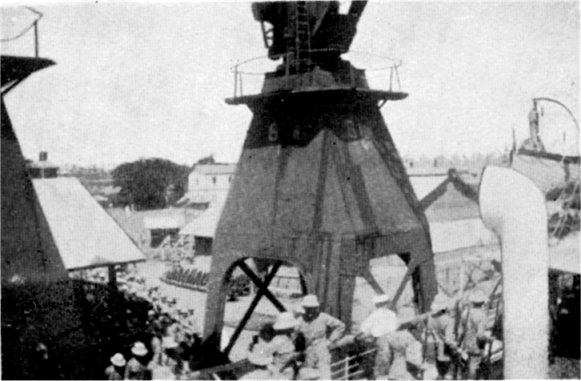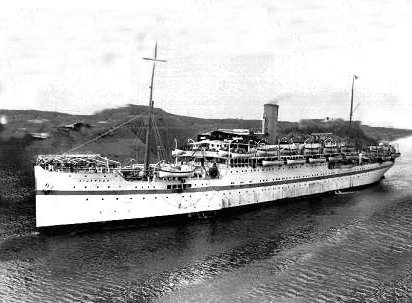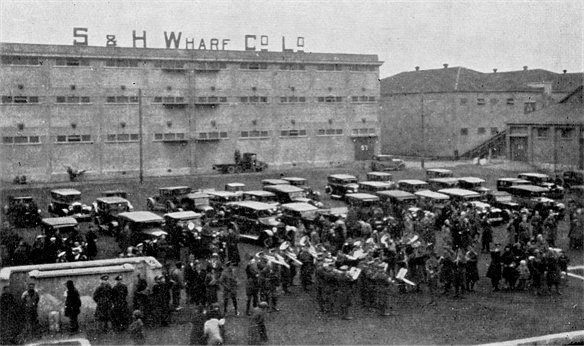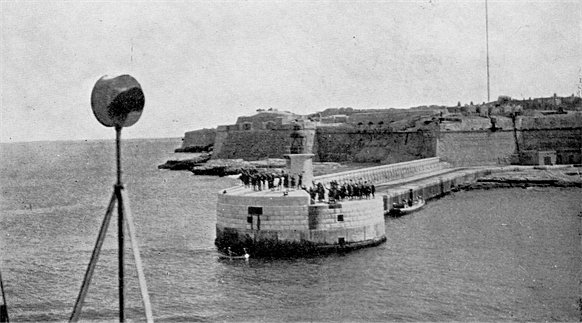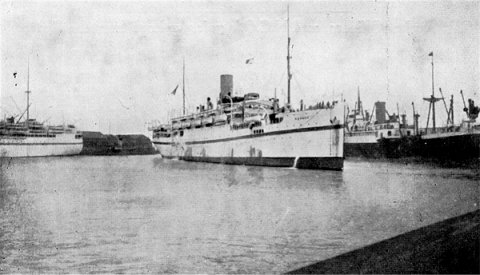1st Battalion Worcestershire Regiment (1928 to 1931)
Bombay to Shanghai and home again
The 1st Battalion embarked in H.M.T. Neuralia at Bombay on the 22nd of October, 1929, and all enjoyed the 17 days voyage to Shanghai. There were few troops on board besides the Battalion, and they had plenty of accomodatjon and deck room. On November 8th the Battalion was in the Whangpoo River off Shanghai — Shanghai is not on the River Yangtsze as is generally thought, but on its tributary, the Whangpoo. An advance party disembarked that night and the Battalion disembarked the following morning and marched the 6 miles to camp with bayonets fixed and Colours flying, led by the band and drums of the 2nd Battalion the Wiltshire Regiment, whom we were to meet again as our next door neighbours at Crownhill. For a week the 1st Battalion were all at Great Western Road Camp, the overflow from the huts being accommodated under canvas, until such time as the Norfolks left and two companies were able to move into the hutted camp at Jessfield Park. During the whole of our stay in Shanghai, Battalion Headquarters, Headquarter Wing and “D” (M.G.) Company were located at Great Western Road, the one rifle company at Great Western Road changed over with one of these at Jessfield Park Camp every two months. |
1st Battalion men passing rifles on board H.M.T. Neuralia prior to embarkation |
H.M.T. Neuralia |
On their march up the Battalion were able to form some first impressions. For most of them, these, perhaps, were on the following lines, Not a bit what they had expected — the shipping in the river — large ocean-going liners and merchantmen — busy wharves and quaysides — the Bund with its trams, fine buildings, and river front, reminiscent of the Embankment in London — battleships of many nations a few hundred yards from the riverside — Nanking Road with its street signs, trams, buses, motors, rickshaws, shops and cinemas. And, last but not least, the crowds of Chinese thronging the streets — all alike and well justifying Mr. Punch’s sentry, who, when asked what he had seen on his beat, replied, ‘a hundred Chinamen or the same Chinaman a hundred times.’ Of the Race Course, where the Battalion had a long halt on the way to camp, more anon. The camp was on the outskirts of the town, just short of the railway line, bounding Chinese territory. Jessfield Park Camp is about one and a half miles from Great Western Road. No sooner had the Battalion arrived, than the Shanghai winter was on them, with rain, snow, and frost. Coming straight from the heat of India, most of the men felt this very much, especially living as they were, in cold and draughty huts. Training in Shanghai was carried out under difficulties, as they could not get out into the country at all. |
The range was 9 miles away on the other side of the city, and they had to proceed there by tram.
When talking of training, they must not forget their weekly route marches in and around the city, and their attendant smells— unless you’ve smelt them, you can’t imagine them.
Small wonder that the Battalion sought some outlet for our energies as soon as the weather began to improve, and that a decision was made to troop the Colour. The difficulties of practising together on account of ground and detached companies were overcome and, on June 1st the Regimental Colour was trooped for the first time since 1908. The Directors of the Shanghai Greyhound Club very kindly lent us the Stadium—a dog racing track—for the purpose, and this ground formed an ideal setting for the ceremony, at the same time the stands providing excellent accommodation from a spectator’s point of view.
We were able to put five guards of 25 files each on parade, and the band and drums numbered 89.
Lieutenant A. H. Gillmore was the Lieutenant of the Escort, and 2nd Lieutenant J. H. A. Dean carried the Colour.
The parade took place in the evening and was concluded with the sounding of Retreat on the massed bugles and the lowering of the Battalion flag at the saluting base. Perhaps one may be permitted to quote from a Shanghai newspaper as to the success of the parade.
“The Glorious First of June, commemorated by the 1st Worcestershires in Shanghai, must go down in the annals of the Battalion's history as one of the most successful on record. It was fittingly celebrated and enabled local residents to participate, to a certain extent, in the pride which the Officers and men of the Regiment feel in connection with the heroic achievments and traditional gallantry of those who, since June 1st, 1794, have followed in the footsteps of the men who made British history on that date. Trooping the Colour is nothing new to Shanghai, having been performed on three previous occasions by British battalions, including the Guards, during their service in the city. But yesterday’s ceremony was outstanding. It was carried through with such clocklike precision, and with such masterly exactitude, that it left the impression of machine-like motion. The men moved as one: their arms were handled as though they were part of the man: the arms drill never varied a fraction, even in the most difficult movements: the marching, both in slow and quick time, was foot perfect: the band was inspiring, and just what one would expect from a Regimental band on such a ceremonial occasion .......”
An interesting factor was the presence of civilians of all nationalities and of naval and military representatives of the U.S.A., France, Italy, and the old Russian Imperial forces; amongst the crowd of some 3000 spectators.
Later, in September, the Battalion gave a Military display on the same ground. The programme was an ambitious one, but the zest with which all ranks took part overcame all difficulties, and they were able to put up an entertainment lasting 2 hours for the Shanghai public, who turned up in force on both nights, and shewed their genuine appreciation of the events. “A” Company provided a display of arms drill and ceremonial guard, mounting with the band and drums. “B” Company scintillated with changing patterns of coloured torches—a difficult drill to get perfect.
“C” Company gave a physical training display. Sergeant Egan and Corporal Bennett trained a gymnastic squad. “D” (M.G.) Company carried out several very effective movements with flaming torches. The Band and drums filled the gaps with marches and selections, and last, but by no means least, Sergeant Sadler and his Pathans gave a very realistic demonstration of a "frontier raid" with torn toms, machine guns, very lights and bombs, the noise of which caused no small consternation in the neighbourhood.
As a result of the sale of programmes at the Trooping of the Colour and the Display, £50 was realised for Regimental charities.
Meanwhile, the Battalion was holding their own in the world of sport and match shooting.
Perhaps the less said about cabarets and Shanghai “night life” generally, the better. Such disclosures might lead to awkward questions!!
As regards sport, the principal difficulty was the paucity of playing grounds and their distance from camps. The men sadly missed the Indian playing grounds. Most of the grounds here were situated on the racecourse, some 3 miles from camp and, but for a generous grant from the Race Club towards sports of the units of the Defence Force, we would have had difficulty in making both ends meet. This large open space in the centre of Shanghai is a great boon and, fortunately, it is understood that the terms of the bequest do not admit of its sale for building purposes. Here all Shanghai collects for recreation— football, rugger, baseball, cricket, hockey, polo are all found here and, with the exception of baseball, we can safely say that the Battalion took their fair share in these events of Shanghai.
Before leaving the Race Course, one cannot omit a word or two regarding that sporting little animal, the China pony. These little animals are brought from the plains of Manchuria, and afford to Shanghai’s riding populace a source of great enjoyment. They can be purchased in the local horse market in the “off” season at anything upward from thirty five Taels (under £3 at the the time). They average about 13.0 to 13.3 hands in height, and it is amazing what weight they can carry, and carry well. They race, play polo, drag hunt and paper hunt. Those who were lucky enough to get a pony or two, will often look back on many pleasant hours spent in one or more of the above equestrian pastimes.
In match-shooting, both with rifle and revolver, the Battalion managed to more than hold their own, even against the Americans with their telescopic sights and automatic pistols.
Some of the men were fortunate enough to see even more of the world than Shanghai. Anti-pirate guards on coastal steamers and Empress liners enabled some to see Hong Kong, Swatow, and Canton.
River steamer guards took others up the River Yangtsze to Hankow and beyond. These latter were specially sought after, as one usually had opportunities for using ones Lewis Gun to stop the activities of “Red” Chinese on the river banks, and it was seldom that one returned without a “bag” of some description.
A few convalescents went to Wei-Hai-Wei, where bathing, boating, and a general seaside life were the order of the day.
A few, still more fortunate, were able to visit Japan, Pekin, and North China on leave. Perhaps some day they will write something of their impressions for the less fortunate to enjoy.
At last, after fifteen months of Shanghai, the Royal Scots Fusiliers arrived in the Nevasa to relieve the Worcesters. Prior to their arrival the Battalion moved to the Race Course where we bivouaced for a week in the racecourse buildings and the stands—rather close, but otherwise good, quarters. On the 6th January 1931, the Battalion marched, with bayonets fixed and Colours flying, as they entered, to the Old Ningpo Wharf, headed by the band of the 4th Regiment of the United States Marines, and embarked in H.M.T. Nevasa for their long six weeks’ journey home, which commenced the next day. Of the voyage home, the outstanding event was the historic meeting of the 2nd Battalion in Malta. Only twice in the history of the Regiment have they met, the previous occasion being, curiously enough, at Malta, in 1896. In the words of the 1st Battalion historical record of the time, “the greatest cordiality prevailed.” and the same remark may aptly be applied to their second meeting. Unfortunately, time did not admit the Battalion proceeding ashore to partake of the hospitality which the 2nd Battalion had arranged, and their meeting was confined to the decks of H.M.T. Nevasa, but was none the less cordial for that. |
The men saying Goodbye to Shanghai |
The action of H.M.S. Worcester in coming out to sea to meet the 1st Battalion with the 2nd Battalion Band and Drums on board was much appreciated by us all, especially as this was the first time the men had met the ship with whom, for so many years, has had so hearty a liaison with the Regiment.
Malta had its sad side too, as it was here that 356 N.C.O.’s and men left the Battalion on turnover to the 2nd Battalion, and they had to say good-bye to many old friends.
2nd Battalion men waving goodbye to the 1st Battalion as they leave Malta |
On their way home the 1st Battalion had called at Hong Kong, Singapore, Colombo, Bombay, Aden, Port Said, Malta, and Gibraltar. At Gibraltar they met “Their Cousins,” the 1st Battalion of the Lincolnshire Regiment, but here again their stay was too short for anything save a hasty visit to renew old acquaintance. The Atlantic fleet was in the harbour, but as the battalion got in after dark and sailed at midnight, faint outlines were all that they could see of what would otherwise have been an interesting spectacle. In spite of the crowded decks it had been possible to hold sports and a boxing tournament on board. The concert party and community singing helped to while away many long evenings. At last, on the 16th February 1931, a cold grey English day, the 1st battalion steamed slowly up Southampton Water. As they drew alongside, many familiar faces could be seen on the quay, where a number of past and present officers of the Regiment had gathered to welcome the men home, a welcome which was much appreciated by all. |
All was then hustle and bustle with baggage, customs and disembarkation, and the men had little time to think of England, until our special train was steaming its way across Hampshire, on its way to Plymouth. Here, too, the Battalion received a splendid welcome, despite the rain, and the lateness of the hour, from Old Comrades resident in Plymouth and the neighbourhood. Three days after the Battalion arrival, they said good-bye to yet another 100 of the old Battalion, to whom they wish all good luck in civil life. A well earned month’s furlough concluded, for those left, the Battalion's tour of foreign service.
|
H.M.T Nevasa entering Southampton Docks at 7.30 a.m. on the 16th February 1931 |

